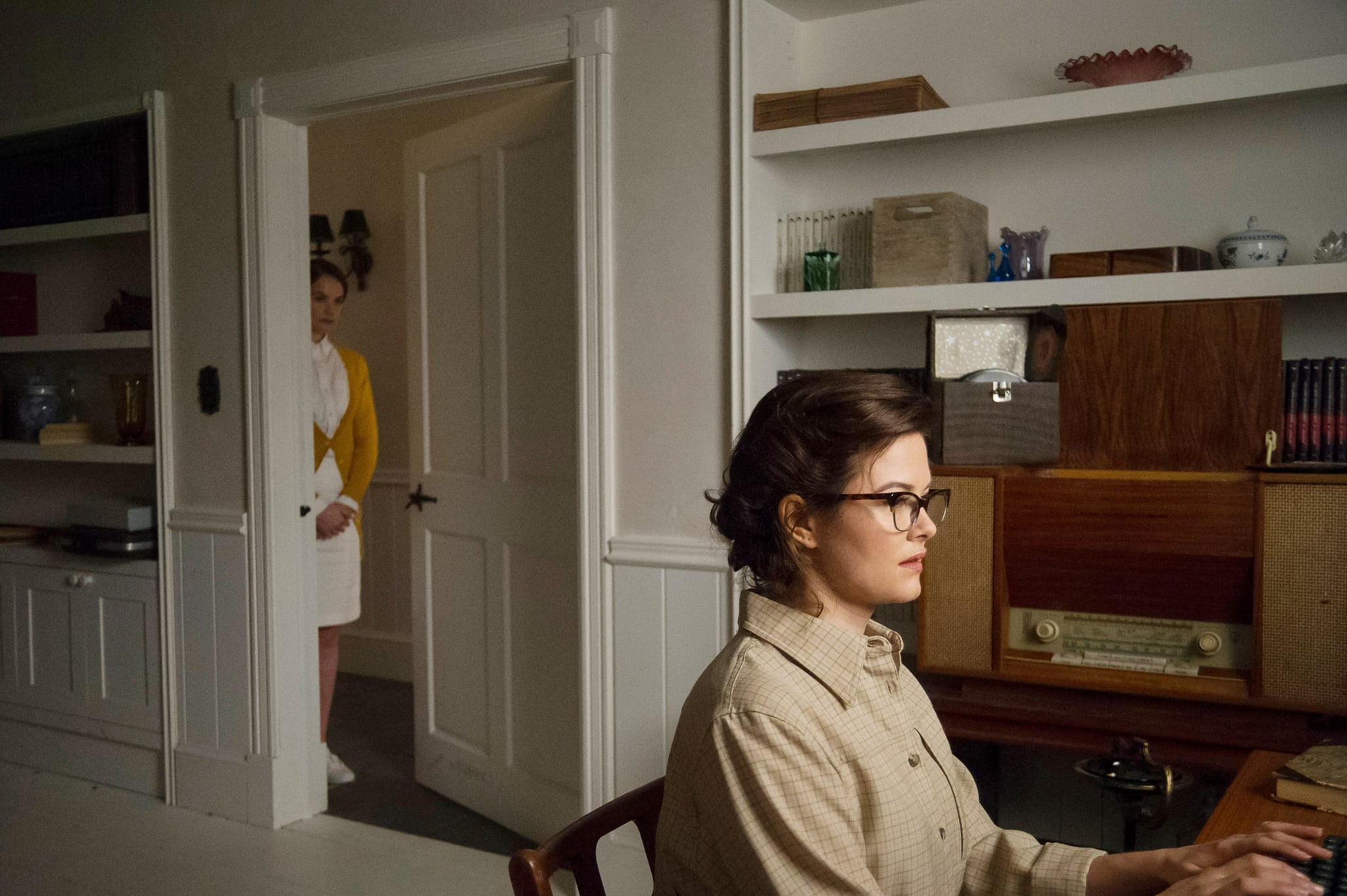I Am the Pretty Thing That Lives in the House is not slasher horror or plain old chills or jump scares. It does not have the cult following of The Conjuring series or a simple name that makes the search easier. Nothing about I Am the Pretty Thing… is easy. It festers like an old wound that had dried up but has been reopened, or the plastered and wallpapered wall of a nursery with the bricks crumbling inside. In fact, wallpaper plays such an important part in I Am the Pretty Thing… that it reminded me of The Yellow Wallpaper by Charlotte Perkins Gilman right in the beginning.
When Lily (Ruth Wilson) moves into famous horror novelist Iris Blum‘s house as her stay-in nurse, nothing seems off. She talks on the phone once the ailing novelist is asleep and stares up at the camera with big deep eyes as if she is trying to figure something out. The calls grow shorter and the person on the other side of the telephone answers back only in static, but Lily keeps coiling the long telephone wire around her fingers trying to reach outside the fog that surrounds her body and soul. As I Am the Pretty Thing… progresses (and it is a slow way forward), the claustrophobia increases, along with the apprehension in Lily as she starts to see an apparition flitting all over the house, emerging from the wallpaper in a white gown, very pretty and very dead.
Also read: Reclaiming Hysteria: Medical Muses By Asti Hustvedt–Not A Book Review
As I Am the Pretty Thing… progresses (and it is a slow way forward), the claustrophobia increases, along with the apprehension in Lily as she starts to see an apparition flitting all over the house, emerging from the wallpaper in a white gown, very pretty and very dead.
The director, Osgood Perkins plays a lengthy game by subverting the gaze of the camera in I Am the Pretty Thing…. He gives us pretty little women (objects?) to stare at and then lets them stare right back at us. From afar, they look pretty and feminine and wholesome and you want to look at them and share a cuppa with them. But when they look back at you, there is sheer devastation and disappointment and deadness inside them which makes them human, not pretty little porcelain dolls wrapped up in the four walls of a room (or in this case, inside the wallpaper).
Lily is deathly scared of horror novels and she picks up and puts down Iris‘ bestseller which is inadvertently the story of the woman inside the wallpaper in I Am the Pretty Thing… What we know of her (Polly) comes from a brief interlude that Lily has with the book and yet the director neglects to tell us her story (or so it seems). We know that Lily will not make it to the next year as she declares that herself right at the very beginning of I Am the Pretty Thing… when she says that she is the pretty thing is the house and that she will never be 29. It would have been simpler to just take it as the truth and move on. However, you cannot because Iris clearly suggests that once there has been a death in a house, the next person moving in is only borrowing it from its ghosts. Iris calls out for Polly over and over again, as Polly rots inside the wallpaper with mold growing all around her. It is Polly‘s story that Iris keeps unfinished.
In The Yellow Wallpaper, we never get to know the story of the wallpaper. In I Am the Pretty Thing…, Perkins gives us a glimpse into Polly‘s horrendous murder and subsequent hiding of her body inside the wallpaper by her husband. The only catch? He doesn’t give us a reason for the violence, but then when has violence against women really needed a reason? People have found reasons that put some, if not all the blame on the woman and husbands have gotten away with murdering their wives (a portrayal of the double standards of patriarchal society). Polly rots and roams inside the walls of the house and yet, as the estate manager says, is not a part of the bone structure of the house at all (and hence the mold keeps on festering). Outside the walls, Lily and Iris (ironically named after flowers) decay and wither into nothingness, eventually forgotten by all except the house that they had borrowed and that will be borrowed from them as time passes.
In I Am the Pretty Thing…, while Lily combs her hair, Ms. Blum constantly blabbers on about being abandoned by her (and by all others) and appearing now, “only to show yourself but not to let me see. You hardly resemble yourself.” These lines bring back the opening monologue and portray a multi-storeyed haunting: the creator haunting the character as an image of her past (living) self—fuzzy and unable to be seen. It also suggests that Iris‘ part in the house is that of an already dead woman: the death of an author who will never pick up the pen again, the death of the character that she has created(or has she?). If Polly is the manifestation of the dead creation and Lily is just like Polly, it is quite understandable why Ms. Blum looks so haunted in I Am the Pretty Thing….

Scenes of Polly herself are interwoven over the film, but she never utters a single word except for the occasional dubbed version. The end is never revealed “in order to be true to the subject, to Polly,” and it becomes clear that Ms. Blum was herself visited by Polly, who probably never could give her the ending. The way she cannot see the ending (death) is what the opening monologue in I Am the Pretty Thing… claims confines ghosts to their haunts. Ms. Blum cannot see Polly’s ending because Polly herself cannot see it, and she sees Lily as the closest she can get to it. Despite Lily angrily sticking to her identity, she becomes a conduit between the dying and the dead for Ms. Blum through this manifestation of Polly.

All the three women in I Am the Pretty Thing… are trapped-in the wallpaper, inside the house and in the realm between the dead and the living, a limbo which they cannot leave because they fear the subsequent ‘panic attack’ and what will happen if they do leave the anxiety behind and move on. Like all frightened little things, they stay in the house.
Also read: Relic Film Review: The Psychological Horror Explores Grief, Trauma & Mental Health
All the three women in I Am the Pretty Thing… are trapped-in the wallpaper, inside the house and in the realm between the dead and the living, a limbo which they cannot leave because they fear the subsequent ‘panic attack’ and what will happen if they do leave the anxiety behind and move on. Like all frightened little things, they stay in the house.
Perkins weaves a classic 2016 tale of a deeply feminist agoraphobia mixed with the subversion of the gaze as he takes slow steps across time and space in I Am the Pretty Thing…, with three women from three different eras, all living in a borrowed house, on borrowed time, that taken from a society which castigates, isolates and murders its women in the name of nothing save violence. It is worthy to remember that murder has forms- you can be killed and tossed inside a wallpaper, your neck bent horribly, or you can be inside the comfort of your home, inside four pretty walls and yet choke to death, similar to the protagonist of The Yellow Wallpaper.
The term agoraphobia comes from the Greek term agora meaning marketplace and is literally ‘a fear of the marketplace’. It is medically coded as a mental disorder on its own terms but is generally considered to be intense fear or terrible anxiety borne out of certain situations like being in open areas, using public transportation, being in closed or cramped areas, standing in line in a crowd or being alone outside the house. However, the cinching of the deal is only when an individual employs avoidance tactics to prevent panic attacks and that the fear must be out of proportion to the danger involved. According to Mason and Chambless, the percentage of women being diagnosed with agoraphobia is much higher than that of men (four times greater).
This has made it a ‘woman’s problem’ and as with a lot of ‘women’s problems’, it has led to a labelling of the lived experiences of agoraphobic women into ‘abnormal’ or ‘irrational’. Feminists believe that the idea that in order to be diagnosed with agoraphobia, the fear has to be ‘out of proportion’ sounds like an alternative way to claim that women are hysterical.
Meghamala Ghosh is an English Literature student at Presidency University, Kolkata. She is interested in war studies, diaspora studies, literary horror and a feminist reworking of the holier-than-thou society we live in. She also works with micro-heritage and is co-founder of The Memory Gazette. When she is not bashing patriarchy, she exists, writes, debates and raids momo counters. She can be found on Facebook and Instagram.
Featured image source: Screen Rant




